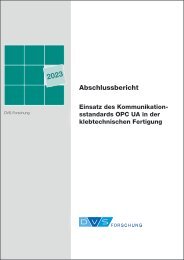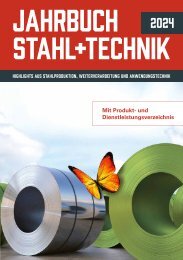You also want an ePaper? Increase the reach of your titles
YUMPU automatically turns print PDFs into web optimized ePapers that Google loves.
Plasma-spray deposition of Na3Zr2Si2PO12 electrolyte for high<br />
performance all solid-state sodium-ion battery<br />
Xiao-Chen Bu, Nan Chen, Xiao-Tao Luo, Chang-Jiu Li *; State Key Laboratory for Mechanical Behavior of<br />
Materials, School of Materials Science and Engineering, Xi'an Jiaotong University, Xi'an/China. Email address:<br />
licj@mail.xjtu.edu.cn.<br />
Abstract<br />
All solid-state sodium-ion batteries (ASS-SIBs) have great potential for application to large-scale energy<br />
storage devices due to their safety advantages by avoiding flammable organics and the abundance of sodium.<br />
In this study, plasma spraying was used to deposit Na3Zr2Si2PO12 (NZSP) electrolyte for assembling<br />
high performance ASS-SIBs. NZSP electrolyte layers were deposited at different spray conditions using<br />
NZSP powders in different particle sizes. The factors influencing the microstructure and compositions of<br />
NZSP layers were examined by characterizing the compositions of splat and cross-sectional microstructures<br />
of the deposits. It was found that the preferential evaporation loss of Na and P elements occurs severely to<br />
result in a large composition deviation from initial powders and spray particle size is key factor which dominates<br />
their evaporation loss. The APS NZSP electrolytes present a dense microstructure with well bonded<br />
splats which is attributed to low melting point of NZSP. The apparent porosity of the as-sprayed NZSPs was<br />
lower than 3 %. The effect of annealing on the microstructure of APS NZSP was also investigated. The performance<br />
of typical APS NZSP was also evaluated by assembling an ASS-SIB battery with APS NaxCoO2<br />
(NCO), Na3Zr2Si2PO12 (NZSP) and Li4Ti5O12 (LTO) as cathode, electrolyte and anode, respectively. Results<br />
showed that columnar-structured grains with a chemical inter-splat bonding were formed across the interfaces<br />
between electrodes and electrolyte. There is no evidence of inter-diffusion of zirconium, cobalt and silicon<br />
across the NCO/NZSP interface. With the preliminary battery, the solid electrolyte exhibited an ionic conductivity<br />
of 1.21 × 10 -4 S cm -1 at 200 o C. The SIB can operate at 2.5 V with a capacity of 10.5 mA h g -1 at current<br />
density of 37.4 μA cm -2 .<br />
Keywords: Sodium-ion battery, NASICON electrolyte, plasma spray, capacity<br />
1 Introduction<br />
Recently sodium ion batteries (SIBs) have drawn great attention due to their great advantages: the abundance<br />
of sodium (2.6 %, while lithium only accounts for 0.06 %), low mining costs and similar electrochemical<br />
performance compared with lithium ion batteries [1-4]. The cost-effective manufacturing of SIBs with absolute<br />
safety are beneficial for large-scale electrochemical energy storage system [2].<br />
For traditional SIBs, liquid organic electrolyte are widely used, which still suffer from severe safety problems<br />
such as liquid leakage and risk of fire [4, 5]. The solid-state Na-ion batteries are of great interest due to their<br />
excellent safety advantage within a large operation temperature range and their potentially high energy densities<br />
when compared to liquid counterparts [6, 7]. NASICON-type electrolytes with a general formula of<br />
Na1+xZr2SixP3-xO12 (0≤x≤3) were first reported by Goodenough and attracted great attention for its high ionic<br />
conductivity (10 -4 -10 -3 S/cm, RT) and chemical stability in air [4, 8]. Ran et al. found that the Sc and Ge codoping<br />
of NZSP can stabilize the rhombohedral phase at RT and significantly boost the sodium ion transfer<br />
[9]. For the synthesis of ceramic electrolyte, solid-state reaction is commonly used. However, the high<br />
reacting temperature (>1200 o C) and long sintering duration (>10 h) may cause the element diffusion across<br />
electrolyte/electrode interface [10-12]. Thus, it is difficult to make a compromise between the sintering temperature<br />
of electrolyte and interface control of electrolyte/electrodes of ASSIBs.<br />
Air plasma spraying (APS), as an efficient and economic coating technique, is theoretically capable of depositing<br />
all kinds of ceramics which have a melting point [13]. For typical as-sprayed deposits of refractory ceramics,<br />
more than 2/3 of the interface between splats are not bonded, which severely reduces the transportation<br />
passage of ions and results in a much lower ionic conductivity along the thickness direction compared<br />
with bulk material [13]. Yao et al. have reported that there exists a critical bonding temperature for certain<br />
ceramic to achieve full bonding between adjacent splats during plasma spraying [14]. The critical bonding<br />
temperature is proportional to the melting point of ceramic coating materials. With ceramic materials of a<br />
melting point lower than 1450 o C, their critical bonding temperature is reduced to around or lower than the<br />
normal temperatutre of 25 o C. This means that with such ceramic materials it becomes easy to deposit a<br />
dense layer with well bonded splats. Fortunately, the NASICON-type electrolytes belong to such ceramic<br />
materials. Besides the microstructure, the chemical composition is also crucial for the ionic conductivity of<br />
NZSP. It has been proved that the extremely high temperature heating of plasma jet usually causes the preferential<br />
evaporation of the constitute in complem ceramics with the high saturation vapor pressure and leads<br />
to the deviation of chemical compositions from stoichiometric ratio of feedstock [15-17]. Zhang et al. reported<br />
8<br />
<strong>DVS</strong> 393

















